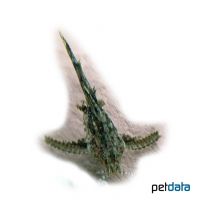Dwarf Moth Catfish (Hara jerdoni)
| Dwarf Moth Catfish Hara jerdoni | |
|---|---|
| Name | Dwarf Moth Catfish |
| Name Lat. | Hara jerdoni |
| Synonym | Erethistes jerdoni |
| Family | Sisorid Catfishes |
| Family lat. | Sisoridae |
| Order | Catfishes |
| Order lat. | Siluriformes |
| Origin | South Asia |
| Habitat | Streams |
| Diet | Omnivore |
| pH | 5.6-7.6 |
| Behavior | Nocturnal, peaceful |
| Keeping | Group |
| Care Level | Moderate |
| Reproduction | Substrate spawner |
| Breeding | Difficult |
| Life Span | 3-5 years |
| Protection | No |
| Metric Units | |
| Size | 3 cm |
| Temperature | 18-24 °C |
| Hardness | 8-15 °dH |
| Aquarium | 60 cm / 54 l |
| US Units | |
| Size | 1.2" |
| Temperature | 64-75 °F |
| Hardness | 142-267 ppm |
| Aquarium | 15 gal |
Distribution and habitat
The small delta wing butterfly catfish are native to southern India and Bangladesh. There they live in oxygen rich, clear and slow flowing streams and small rivers with soft muddy bottoms. During the day they usually stay hidden under roots or in stone caves.
Maintenance
They require an aquarium with dense marginal planting and many hiding places, such as stone caves (e.g. perforated rocks, catfish burrows) and roots. A soft sandy substrate covered with some beech or oak foliage, slightly dim light (e.g. floating plants), oxygen-rich water and a weak current is ideal
No ammonia, ammonium and nitrite should be detectable, the nitrate value should not exceed 100 mg/l. To ensure the water quality and oxygen content, a filter and heater adapted to the aquarium size is required, as well as lighting for the species-appropriate day-night rhythm of the animals.
Diet
The food supply consists mainly of live food, such as cyclops, daphnia, artemia, enchytraea and mosquito larvae, which are also eaten frozen without problems or a commercial frozen food mix for catfish. In addition, they need regular vegetable food, such as algae leaves. Sometimes sinking dry food for catfish with high vegetable content (spirulina, kelp) is also accepted, but should not be the main component of the diet
A regular and varied diet promotes health and prevents deficiency symptoms. Only as much should be fed as is eaten in a few minutes.
Behaviour and compatibility
It is recommended to keep these calm, nocturnal fish in a group of at least 5 animals. They are very peaceful and can be socialized well with other calm and small fish (nano fish). Socialization with larger, bottom-dwelling fish is not recommended. Basically, only compatible fish species with similar demands on water conditions and water temperature should be socialized.
Sex dimorphism
No external distinguishing characteristics are known. Sexually mature females appear rounder and grow slightly larger than males.
Reproduction and breeding
The breeding in the aquarium has already succeeded several times. Moss balls are used for egg laying, in which one of the animals drills a hole with its head, in which the eggs are deposited and guarded. After about 8 days the tiny catfish hatch and emerge from the moss cushion
Commercially available liquid food for egg-laying fish or infusoria is suitable as initial food. The fry must be fed several times a day. Breeding is hardly possible in community tanks, as the fry are easy prey.
Important
The permanent keeping above 24 °C is not tolerated.
During the day they usually stay hidden between plants and in rock crevices, while at night they move through the aquarium like schooling fish. When they are introduced into the aquarium, they often let themselves sink motionless to the ground.
When catching them, use as fine-meshed nets as possible so that the very thin pectoral fins cannot get caught.
The well-being of the fish should be checked regularly. Temperature should be checked daily, pH, hardness and nitrate levels at least every 14 days. Regular partial water changes are recommended, even if the contaminant level has not yet reached the upper limit. Sudden changes in water quality should be avoided. Newly introduced fish must be accustomed slowly to the water in the aquarium
Further literature can be found in your pet store.
References
Text: Werner Winter; Image: petdata
Source: BMELV (1998): Tierschutzgutachten - Haltung von Zierfischen (Süßwasser); BAENSCH & RIEHL (2004): Aquarien Atlas Bd. 4, Mergus Verlag; ENGELMANN (2005): Zootierhaltung - Tiere in menschlicher Obhut: Fische, Verlag Harri Deutsch
- Gemäß § 21 Abs. 5 Tierschutzgesetz idgF
